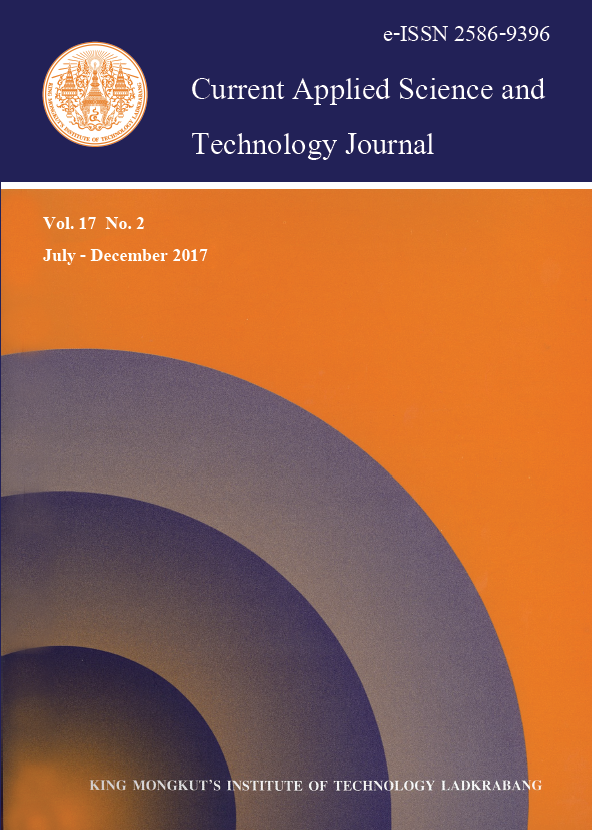Incorporation of Shrinkage into Two Layer Diffusion Model for Air Drying
Main Article Content
Abstract
Shrinkage was modelled using a simple moisture volume displacement and incorporated into an existing two layer diffusion drying model. The resulting combined model was tested using shrinkage and drying data for banana slices (approximately 5 to 9 mm thickness) from three sets of conditions measured in replicate, over a range of conditions from 28-38°C and 12-30% relative humidity, using a heat pump dryer. Experiments for carrot were conducted at the same drying conditions for three different slice thicknesses: 3, 5 and 8 mm. The shrinkage model provided better agreement for carrot than for banana, but both were considered adequate fits and so the model was included in the drying rate equation. Parameters for the combined model were estimated by regression. It was found that on average, the prediction of the shape of the moisture-time drying curves was improved by inclusion of shrinkage in the two layer model, as the R² values of the model for banana and carrot increased by 9% and 14% respectively. The results confirmed that product shrinkage affects moisture transfer, and should be included in predictive model development.
Keywords: Shrinkage, Drying, Moisture Diffusion
*Corresponding author:
E-mail: bithika.saha@unsw.edu.au
Article Details
Copyright Transfer Statement
The copyright of this article is transferred to Current Applied Science and Technology journal with effect if and when the article is accepted for publication. The copyright transfer covers the exclusive right to reproduce and distribute the article, including reprints, translations, photographic reproductions, electronic form (offline, online) or any other reproductions of similar nature.
The author warrants that this contribution is original and that he/she has full power to make this grant. The author signs for and accepts responsibility for releasing this material on behalf of any and all co-authors.
Here is the link for download: Copyright transfer form.pdf
References
[2] Hatamipour, M. and Mowla, D., 2002. Shrinkage of carrots during drying in an inert medium fluidized bed. Journal of Food Engineering, 55(3), 247-252.
[3] Suarez, C. and Viollaz, P.E., 1991. Shrinkage effect on drying behavior of potato slabs. Journal of Food Engineering, 13(2), 103-114.
[4] Lozano, J., Rotstein, E. and Urbicain, M., 1980. Total porosity and open‐pore porosity in the drying of fruits. Journal of Food Science, 45(5), 1403-1407.
[5] Ratti, C., 1994. Shrinkage during drying of foodstuffs. Journal of Food Engineering, 23(1), 91-105.
[6] Wang, N. and Brennan, J., 1995. Changes in structure, density and porosity of potato during dehydration. Journal of Food Engineering, 24(1), 61-76.
[7] Krokida, M.K. and Maroulis, Z.B., 1997. Effect of drying method on shrinkage and porosity. Drying Technology, 15(10), 2441-2458.
[8] Zogzas, N.P., Maroulis, Z.B. and Marinos-Kouris, D., 1994. Densities, shrinkage and porosity of some vegetables during air drying. Drying Technology, 12(7), p. 1653-1666.
[9] Lozano, J., Rotstein, E. and Urbicain, M., 1983. Shrinkage, porosity and bulk density of foodstuffs at changing moisture contents. Journal of Food Science, 48(5), 1497-1502.
[10] Shafiur Rahman, M. and Lal Potluri, P., 1990. Shrinkage and density of squid flesh during air drying. Journal of Food Engineering, 12(2), 133-143.
[11] Perez, M. and Calvelo, A., 1984. Modeling the thermal conductivity of cooked meat. Journal of Food Science, 49(1), 152-156.
[12] Palipane, K.B. and Driscoll, R.H., 1994. The thin-layer drying characteristics of macadamia in-shell nuts and kernels. Journal of Food Engineering, 23(2), 129-144.
[13] Phoungchandang, S. and Woods, J., 2000. Moisture diffusion and desorption isotherms for banana. Journal of Food Science, 65(4), 651-657.
[14] Kechaou, N. and Maalej, M., 1994. Evaluation of diffusion coefficient in the case of banana drying. Drying Technology, 94, 841-848.
[15] Madamba, P., Driscoll, R. and Buckle, K., 1994. Shrinkage, density and porosity of garlic during drying. Journal of Food Engineering, 23(3), 309-319.
[16] Zogzas, N., Maroulis, Z. and Marinos-Kouris, D., 1996. Moisture diffusivity data compilation in foodstuffs. Drying Technology, 14(10), 2225-2253.
[17] Phoungchandang, S. and Wongwatanyoo, J., 2010. Desorption isotherms and drying characteristics of carrot using tray and heat pump-assisted dehumidified drying. KKU Research Journal, 15(3), 171-186.
[18] Mayor, L. and Sereno, A., 2004. Modelling shrinkage during convective drying of food materials: A review. Journal of Food Engineering, 61(3), 373-386.
[19] Helrich, K., 1990. Official methods of Analysis of the AOAC. Volume 2. Association of Official Analytical Chemists Inc.
[20] Wu, X., Srzednicki, G. and Driscoll, R., 2012. Thin layer drying of ginger. in Southeast Asia Symposium on Quality Management in Postharvest Systems and Asia Pacific Symposium on Postharvest Quality 989.
[21] Sahari, Y. and Driscoll, R., 2013. Thin layer drying of agricultural products: A review. in Third Malaysian Postgraduate Conference (MPC) 2013.
[22] Noomhorm, A. and Verma, L.R., 1986. Generalized single-layer rice drying models. Transactions of the ASAE, 29(2), 587-591.


